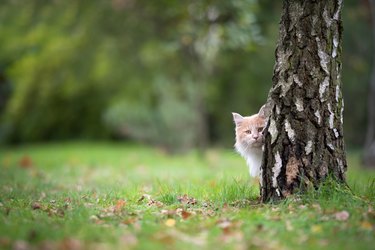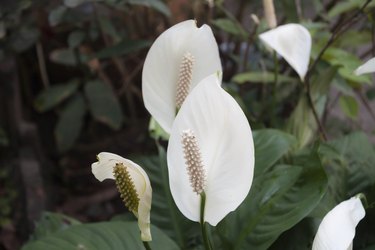Peace lilies, with their white flowers waving like white flags of peace, symbolize inner harmony and healing in many cultures. Just don't expect them to bring inner harmony to your pets. Peace lilies make the list of poisonous plants for dogs and cats because of the stomach upset and other distressing symptoms they bring to those who chew on the plant's leaves and flowers.

Video of the Day
Is the peace lily pet-safe?
Also known as the Mauna Loa plant, white sails, and their scientific name Spathiphyllum, peace lilies are most definitely not pet-safe. When an animal chews on the leaves, insoluble calcium oxalate crystals are released, and animals immediately feel an intense burning of the mouth, lips, tongue, and throat. This can be followed by an extreme amount of drooling, foaming, vomiting, and diarrhea. It should be noted, however, that cats and dogs will often vomit after eating any plant or parts of a plant regardless of whether the plant is considered to be toxic or nontoxic to them.
Video of the Day
Rare side effect of difficulty breathing
In general, peace lilies are considered to be only mildly toxic to cats and dogs. They will probably cause your pet to vomit, but your pet is not in any real danger. An exception to watch for, though, is if your pet seems to be having trouble breathing. This can happen when the animal's throat becomes inflamed and swollen from the calcium oxalate crystals. If your pet appears to be in respiratory distress or if you aren't sure, that warrants at least a call to your vet for advice and probably a visit to be safe.
Identifying peace lilies

Peace lilies are recognized by their erect white curved flowers and typically shiny emerald-green leaves. The flowers, which are usually white, serve as a hood to protect the spadix or spathe, which is the spike of small flowers held upright in the center. As the flowers age, the spathe fades to green. While most peace lily plants have lush green leaves, some varieties have tinges or stripes of cream in the center of the leaves. Plants can grow to be up to 3 feet tall.
Cats cannot digest plant materials
Cats in particular are carnivores, and their gastrointestinal tracts are not suited to digesting plant material, so they will vomit any they ingest. In addition, cats require the amino acid taurine, which is only found in meat sources. When cats experience a taurine deficiency, they can develop dilated cardiomyopathy, or a weakened heart muscle, which is fatal if not corrected. Dogs also need taurine, but their bodies can produce it from two other amino acids, which cats cannot do.
Other lilies can be deadly
Plants in the "true lily" and "daylily" families can cause kidney failure in cats and should be considered too dangerous to have in your home or garden. These include Asiatic lilies and their hybrids, daylilies, Easter lilies, Japanese show lilies, Oriental lilies, rubrum lilies, stargazer lilies, tiger lilies, and wood lilies. All parts of these plants are extremely toxic, even their roots, tubers, and pollen, and licking just a small amount of water from a vase holding these lilies is also dangerous.

Gastrointestinal symptoms may start immediately or up to 12 hours after eating the dangerous plant. You might also notice listlessness and lack of appetite, including not drinking water, which then leads to dehydration. Signs of kidney failure, including dehydration and increased urination, can occur about 12 hours after ingestion. At the 18-hour point, kidney failure is likely and may be irreversible, so call your vet or take your pet to an emergency clinic or hospital as soon as you believe she's eaten a highly poisonous lily.
Cat-safe plants to try
Some plants are OK to have around cats, because even if they chew on them they won't be harmed. Try Swedish ivy, Christmas cactus, and Boston ferns. Be sure to choose the exact plant that is listed as cat-safe, though; for example, while Boston ferns are fine, other varieties of ferns can be toxic to cats. And remember that cats may still vomit any plant material, including non-toxic ones, because they can't digest it.
- Pet Poison Helpline: Peace Lily
- American Society for the Prevention of Cruelty to Animals: Poisonous Plants
- Florgeous: Peace Lily Flower Meaning and Symbolism
- American Society for the Prevention of Cruelty to Animals: Why Can't My Cat Be Vegan?
- U.S. Food & Drug Administration: Lovely Lilies and Curious Cats: A Dangerous Combination
- Better Homes & Gardens: Peace Lily